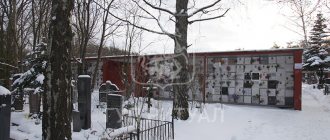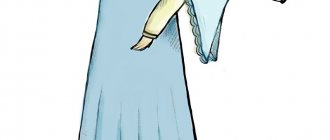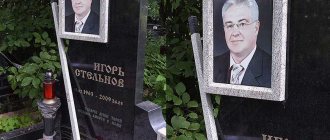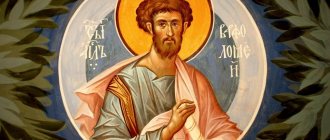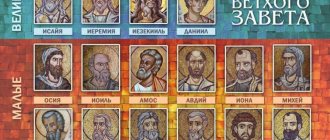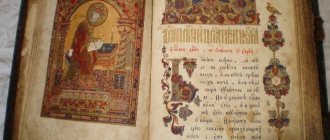The first part of the Liturgy Proskomedia or “Offering”
The first part of the Liturgy, in which the substance for the Sacrament is prepared, is called “offering,” because at the appointed time, ancient Christians brought bread and wine for the Eucharist, which is why the bread itself is called “prosphora,” that is, “offering.”
The substance for the Sacrament is bread and wine. The bread must be leavened (risen), pure, wheat. The bread must be leavened, and not unleavened, because the Lord Jesus Christ Himself took leavened bread to perform the Sacrament. Wheat bread is also taken following the example of Jesus Christ and also because Jesus Christ compared Himself to a grain of wheat (John XII: 24).
In appearance, bread (prosphora) consists of:
- of two parts joined together to designate the two natures of Jesus Christ - Divine and human.
- with the designation of a cross as a sign that this bread is intended for sacred use,
- with the inscription on the sides of the cross Christ the Victorious.
The wine must be grape and red, because Jesus Christ Himself consumed grape wine at the Last Supper. In Proskomedia, when remembering the suffering of the Savior, wine is combined with water, signifying that during the Suffering of the Savior, blood and water flowed from His pierced rib.
For Proskomedia, five loaves or prosphoras are used, but actually for Communion one (the Lamb) is used, as the Apostle says: “One bread, one body we are many: for we all partake of one bread” (1 Cor. X, 17).
General outline of Proskomedia
After vesting (the vesting of the clergy before the Liturgy is done after reading some of the prescribed prayers, in front of the Royal Doors, which is called “performing the entrance”) in all sacred vestments and uttering the initial “exclamation” for the reading of the hours by the psalmist, the priest proceeds to the altar.
Having made three prostrations before the altar with a prayer for the cleansing of sins, the priest takes the first prosphora and with a copy makes the sign of the cross on it three times, saying: “In remembrance of the Lord and God and our Savior Jesus Christ.” This means: we begin to celebrate the Liturgy according to the covenant of Jesus Christ and in remembrance of Him. Then, pronouncing the prophetic words of the prophet Isaiah, the priest makes a cut with a copy on four sides of the middle of the prosphora.
This is how the cubic part of the prosphora stands out and is called the Lamb. The priest places this cubic part (called the Lamb) taken from the prosphora on the paten, cuts the seal crosswise on the opposite side, while pronouncing the words: “One soldier with a copy of His side was pierced and blood and water came out” (John 19:34).
In accordance with these words, wine combined with water is poured into the cup. Having completed the preparation of the Holy Lamb, the priest takes out particles from the following prosphoras.
A particle is taken out of the second prosphora in honor and memory of our Most Blessed Lady Theotokos and Ever-Virgin Mary and placed on the right side of the Holy Lamb.
From the third prosphora, 9 particles are taken out in honor of the nine ranks of the Saints of God and placed on the left side of the Holy Lamb, three particles in a row.
Particles are taken out from the fourth prosphora for the living. The particles taken out about health are placed below the Holy Lamb.
From the fifth prosphora, particles are taken out for the dead and placed below the particles taken out for the living.
After removing the particles, the priest blesses the censer with incense, censes the star and places it on top of the Holy Bread on the paten. Then, having sprinkled incense on the first cover, the priest covers the Holy Bread with the paten with it; Having sprinkled the second cover, the priest covers the Holy Chalice (chalice) with it; finally, having sprinkled a large cover, which is called “air” (the word “air” is the name given to the large cover because, blowing it at the Liturgy during the symbol of faith, the priest vibrates the air), the priest covers the paten and the Holy chalice together with it, saying at each covering the appropriate prayer.
Then the priest censes the Holy Altar and reads a prayer in which he asks the Lord to accept the gifts into “His most heavenly altar,” to remember those who brought the gifts and for whom they were brought, and to preserve the clergy themselves without judgment in the celebration of the Divine Mysteries.
During Proskomedia, the 3rd, 6th, and sometimes 9th hours are read on the choir.
At the third hour, we remember the scourging and outrage of Jesus Christ after the trial by Pilate and, on the other hand, the descent of the Holy Spirit on the Apostles, which happened around 9-10 o’clock in the morning according to our account). Therefore, in the psalms (16, 24, 50) and prayers one hears, on the one hand, an appeal on behalf of the Innocent Sufferer, and on the other hand, a reminder of the Holy Spirit.
At the sixth hour (in our opinion, 12–1 o’clock), the voluntary suffering and crucifixion of Jesus Christ on Calvary are remembered. Therefore, the psalms (53, 54, 90) talk about suffering. In general, the psalms of the 6th hour depict the attempt of the Jews on the life of the Lord and the machinations to kill Him, their ridicule and curses, the earthquake and the darkness that then covered the earth, etc. The last one, Psalm 90: “He lives in the help of the Most High ”, indicates help from the Father to the Son in His sorrow, and in the words: “Treading on the asp and basilisk,” etc. - to His victory over hell.
At the ninth hour (in our opinion, 3–4 o’clock), the Death on the Cross of Jesus Christ is remembered and its significance for our salvation is depicted.
The psalms (83, 84 and 85) point to “salvation accomplished through the death of Christ” to the fact that “He is the living God, died for us in the flesh, and was a sacrifice for us and obtained favor for the earth, which He brought back from captivity - our souls, and revived us with his resurrection, made his people glad, and spoke peace”; finally, it is said that in the suffering of Jesus Christ “mercy and truth met, righteousness and peace kissed each other” (Ps. 84).
Psalm 85 - “Incline, O Lord, Thy ear: prophetically depicts that He who was crucified and died for us is holy, good, meek, abundantly merciful, true, that He gave us strength, strength and did a sign for good.
Psalm 83 speaks of the future faith of the pagans in Jesus Christ, that “people will go from strength to strength, the God of gods will appear in Zion.”
The New Testament events remembered on the clock are spoken of especially clearly in the following troparions, which are read and sung only during Lent.
Troparion of the 1st hour: Tomorrow hear my voice, my King and my God.
Hear my voice in the morning, my King and my God.
Troparion of the 3rd hour: Lord, who sent down Thy Most Holy Spirit in the third hour by Thy Apostle: Take not that Good One from us, but renew us who pray to Thee.
You, Lord, Who at the third hour sent down the Holy Spirit on the Apostles, do not take this Spirit away from us, but renew us who pray to You.
Troparion of the 6th hour: And on the sixth day and hour on the cross the daring sin of Adam was nailed to paradise, and tear up the handwriting of our sins, O Christ God, and save us.
Lord, You, Who on the sixth day and at the sixth hour nailed to the cross Adam’s sin, which he boldly committed in paradise, tear away the record of our sins, O Christ God, and save us.
Troparion of the 9th hour: For at the ninth hour you tasted death for our flesh, put to death our wisdom in the flesh, O Christ our God, and save us.
Lord, Christ God, who tasted death for us in His flesh at the ninth hour of the day, put to death the wisdom of our flesh and save us.
Clock diagram
- Normal start
- Three psalms - at the 1st hour - 5, 89 and 100; at the 3rd hour - 16, 24 and 50; at the 6th hour - 53, 54 and 90; at the 9th hour - 83, 84 and 85 ps.
- Glory and now alleluia
- Troparion of the “hour”, holiday or Saint, (“Daily” troparion from Octoechos, and to the Saint - from the “Menaia”)
- Theotokos
- Trisagion, "Our Father"
- Kontakion of the holiday or Saint (Kontakion of the day - from Octoechos, and the Saint - from Menaion)
- “Lord have mercy” 40 times. “Glory even now”, “The most honorable cherub”
- Prayer: “For every time and every hour”
- Closing prayer to the Lord Jesus
Note: Troparion and kontakion from Oktoechos only on Sunday or Lent.
Directions for reading the Apostle
The reader must receive a blessing from the serving priest to put on the surplice and to read the Apostle, after which he goes to the indicated place to read the appointed Apostle.
After the choir sings the Trisagion and the priest exclaims: “Peace to all,” the reader says: “And to your spirit.” Deacon: “Wisdom”, the reader pronounces the prokeimenon. The choir sings the prokeimenon, then the reader recites the verse, and the choir sings the prokeimenon a second time. Next, the reader pronounces the first part of the prokeimna, and the choir sings the second part. At the end of the singing of the prokeemna, the deacon exclaims: “Wisdom,” and the reader pronounces the inscription of the apostolic reading, for example: “Reading the Acts of the Apostle,” “Reading the Catholic Epistle of John,” “Reading the Epistle of the Holy Apostle Paul to the Galatians.” Deacon: “Let us hear,” the reader reads more appropriately the conception of the Apostle.
At the end of reading the Apostle, the priest quietly pronounces “Peace be upon you,” the reader answers him in the same tone: “And to Thy Spirit.” Deacon: "Wisdom." The reader, after saying: “And to Your Spirit,” immediately says: “Alleluia” (three times). The choir sings: “Alleluia” (three times). The reader says the verse, the xop sings a second time: "Alleluia", then the reader says the second verse, and the choir sings a third time: "Alleluia". The reader, having crossed himself, enters the altar through the southern doors, takes a blessing from the serving priest and then unmasks himself.
On some days there are two apostolic readings and two prokemenas. The order of singing the prokeimenon is as follows: the reader pronounces the first prokeimenon, the choir sings this prokeimenon, then the reader pronounces the verse of the prokeimenon, and the choir sings the prokeimenon a second time. Next, the reader, instead of the first half of the prokeimenon, pronounces the second prokeimenon. The choir also sings the second prokeimenon.
Some prokeimnas have inserted words, for example: prokeimnas for the feasts of the Mother of God. "Song of the Mother of God", prokeimenon on the Sunday of Sts. Fathers: “Song of the Fathers.”
The alleluary is always sung only three times. Some alleluaries have one verse instead of two; in this case, it must be divided into two parts or repeated. If two alleluaries are given, the first verse should be taken from one, the second verse from the other. At the Liturgy, more than two apostolic readings are not read, two began. If on any day you have to read three apostolic conceptions, then they are read as two, i.e. one conception is read “under conception” with the other.
Note: The expression “under conception” means that the two Apostles are read as if they constitute one conception, i.e. There is no long pause between the readings of two conceptions.
When reading the two apostolic principles, the following order is observed:
1. First, the conceptions of the day (i.e. Ordinary) are read, then to the saints:
a) on all days of the week, except Saturday;
b) on Saturdays from the Sunday of the Publican and the Pharisee to the Sunday of All Saints, i.e. during the period of singing the Lenten and Colored Triodion.
c) on all Sundays (except for the weeks before the Exaltation and after the Exaltation, the week after the Nativity of Christ),
d) on the days of the dedication of the Theotokos feasts, the ordinary conception is first read, and then to the Mother of God.
2. The apostle is read first to the saint, and then to the ordinary on Saturdays from the Sunday of All Saints until the Sunday of the Publican and the Pharisee.
Note: In the Apostle there are conceptions designated by the word “from the floor,” i.e. from half.
Divine Liturgy
We have already said that the liturgy is the main, most important service; during it the Sacrament of the Eucharist , or the Sacrament of Communion . This Sacrament was first performed by our Lord Jesus Christ Himself on the eve of His suffering, on Maundy Thursday. The Savior, having gathered all the apostles together, gave praise to God the Father, took bread, blessed it and broke it. He gave it to the holy apostles with the words: Take, eat: this is My Body. Then He took the cup of wine, blessed it and gave it to the apostles, saying: Drink of it, all of you: for this is My Blood of the New Testament, which is shed for many for the remission of sins (Matthew 26:28). The Lord also commanded the apostles: Do this in remembrance of Me (Luke 22:19). Even after the resurrection of Christ and His ascension to Heaven, the apostles performed the Sacrament of Communion. During the Eucharist (Greek thanksgiving), each time what the Lord did at the Last Supper is actually accomplished. We mysteriously, under the guise of bread and wine, partake of the Divinity Himself - the Body and Blood of the Savior . He abides in us, and we abide in Him, as the Lord said (see: John 15:5).
The Eucharist is also called the Bloodless Sacrifice , because it is an image of the sacrifice that the Lord Jesus Christ made for us on Calvary. He accomplished it once, having suffered for the sins of the world, was resurrected and ascended to Heaven, where he sat down at the right hand of God the Father. The sacrifice of Christ was offered once and will not be repeated. With the establishment of the New Testament, Old Testament sacrifices ceased, and now Christians perform the Bloodless Sacrifice in remembrance of the sacrifice of Christ and for the communion of His Body and Blood.
The Old Testament sacrifices were only a shadow, a prototype of the Divine sacrifice. The expectation of the Redeemer, the Liberator from the power of the devil and sin is the main theme of the entire Old Testament, and for us, the people of the New Testament, the sacrifice of Christ, the Savior’s atonement for the sins of the world, is the basis of our faith.
The Holy Gifts are a fire that burns up every sin and every defilement if a person strives to receive communion worthily. We receive communion for the healing of soul and body. When starting communion, you need to do it with reverence and trembling, realizing your weakness and unworthiness. “Although you eat (eat), O man, approach the Master’s Body with fear, so as not to be burned: for there is fire,” says the prayers for Holy Communion.
Saint Ignatius (Brianchaninov) writes about how the Lord enlightened one young man, Dmitry Shepelev, and showed that the true Body of the Savior is served in Holy Communion: “He was brought up in the Corps of Pages. Once during Great Lent, when the pages were fasting and already beginning the Holy Mysteries, the young man Shepelev expressed to a comrade walking next to him his decisive disbelief that the Body and Blood of Christ were in the chalice. When the secrets were taught to him, he felt that there was meat in his mouth. Horror seized the young man: he stood beside himself, not feeling the strength to swallow the particle. The priest noticed the change that had taken place in him and ordered him to enter the altar. There, holding a particle in his mouth and confessing his sin, Shepelev came to his senses and used the Holy Mysteries taught to him” (“Fatherland”).
Often, spiritual people and ascetics experienced phenomena of heavenly fire descending on the Holy Gifts during the celebration of the Eucharist. Yes, the Sacrament of Communion, the Eucharist is the greatest miracle and mystery, as well as the greatest mercy for us sinners, and visible evidence that the Lord established a New Covenant with people in His Blood (see: Luke 22:20), sacrificing for us cross, died and rose again, spiritually resurrecting all humanity with Himself. And we can now partake of His Body and Blood for the healing of soul and body, abiding in Christ, and He will “abide in us” (see: John 6:56)[1].
Origin of the liturgy
Since ancient times, the sacrament of communion, the Eucharist, has also received the name liturgy , which is translated from Greek as a common cause, a common service .
The holy apostles, disciples of Christ, having accepted from their Divine Teacher the commandment to perform the Sacrament of Communion in remembrance of Him, after His Ascension they began to break bread - the Eucharist. Christians continued constantly in the teaching of the Apostles, in fellowship, in the breaking of bread and in prayer (Acts 2:42).
The order of the liturgy was formed gradually. At first, the apostles celebrated the Eucharist in the very order that their Teacher taught them. In apostolic times, the Eucharist was combined with the so-called agapes , or meals of love. Christians ate food and were in prayer and fraternal fellowship. After the supper, the breaking of bread and communion of the believers took place. But then the liturgy was separated from the meal and began to be performed as an independent sacred rite. The Eucharist began to be celebrated inside sacred churches. In the 1st–2nd centuries, the order of the liturgy was apparently not written down and was transmitted orally.
What are the liturgies?
Liturgy of the Apostle James
Gradually, different localities began to develop their own liturgical rites. The Liturgy of the Apostle James was served in the Jerusalem community . The liturgy of the Apostle Mark was celebrated in Alexandria and Egypt . In Antioch - the liturgy of Saints Basil the Great and John Chrysostom. All these liturgies are united in their meaning and meaning, but differ in the texts of the prayers that the priest offers during the consecration of the Holy Gifts.
Now in the practice of the Russian Orthodox Church there are usually three rites of the liturgy . These are the liturgy of St. John Chrysostom, the liturgy of St. Basil the Great and the liturgy of St. Gregory the Great .
Liturgy of St. John Chrysostom
Liturgy of St. John Chrysostom
This liturgy is celebrated on all days of the year, except for the first five Sundays of Great Lent and weekday Lenten days. Saint John Chrysostom composed the order of his liturgy based on the previously composed liturgy of Saint Basil the Great , but shortened some prayers.
Liturgy of St. Basil the Great
According to the legend of Saint Amphilochius, Bishop of Iconium, Saint Basil the Great asked God “to give him the strength of spirit and mind to perform the liturgy in his own words. After six days of fiery prayer, the Savior miraculously appeared to him and fulfilled his request. Soon Vasily, imbued with delight and divine awe, began to proclaim: “Let my lips be filled with praise,” “Take in, Lord Jesus Christ our God, from Thy Holy Dwelling,” and other prayers of the liturgy.”
The Liturgy of St. Basil is celebrated ten times a year :
on the eve of the Nativity of Christ and Epiphany (on the so-called Christmas and Epiphany Eves), on the day of remembrance of St. Basil the Great on January 1 (January 14, new style), on the first five Sundays of Lent, on Holy Thursday and on Holy Saturday.
Liturgy of St. Gregory the Dvoeslov, or Liturgy of the Presanctified Gifts
Liturgy of St. Gregory Dvoeslov
During the Holy Pentecost of Great Lent, the service of the full liturgy ceases on weekdays. Lent is a time of repentance, crying over sins, when all festivity and solemnity are excluded from worship. And therefore, according to church rules, the Liturgy of the Presanctified Gifts . The Holy Gifts, with which believers receive communion, are consecrated at the Liturgy on Sunday.
In some Local Orthodox Churches, on the day of remembrance of the Holy Apostle James (October 23, old style), a liturgy is served according to his rite.
Sequence and symbolic meaning of the liturgy
The order of performing the full liturgy (that is, not the liturgy of the Presanctified Gifts) is as follows. First, the substance for celebrating the Eucharist is prepared. Then the believers prepare for the Sacrament. And finally, the Sacrament itself is performed - the consecration of the Holy Gifts and the communion of believers. The Divine Liturgy thus has three parts: proskomedia; Liturgy of the Catechumens; Liturgy of the Faithful .
Proskomedia
This word is Greek and translated means bringing . In ancient times, members of the early Christian community themselves brought before the liturgy everything necessary for the Sacrament: bread and wine. The bread used during the liturgy is called prosphora, which means offering (in ancient times, Christians themselves brought bread to the liturgy). In the Orthodox Church, the Eucharist is celebrated on prosphora made from leavened (yeast) dough.
For proskomedia, five prosphoras in memory of the miraculous feeding of five thousand people by Christ.
For communion, one prosphora (lamb) is used. For the Lord also gave communion to the apostles, breaking and distributing one loaf. The Holy Apostle Paul writes: there is one bread, and we, who are many, are one body; for we all partake of one bread (1 Cor 10:17). The Lamb is crushed after the transfiguration of the Holy Gifts, and the clergy and all those preparing for communion receive communion with it. During the liturgy, red grape wine is used, as it resembles the color of blood. Wine is mixed with a small amount of water as a sign that blood and water flowed from the Savior’s pierced rib.
Proskomedia is performed at the very beginning of the liturgy in the altar while the reader is reading the hours. The exclamation “Blessed is our God,” which precedes the reading of the third hour , is also the initial exclamation of the proskomedia. Before the liturgy, the sequence of the third and sixth hours .
Proskomedia is a very important part of the Divine Liturgy, and the preparation of the Gifts for consecration has deep symbolic meaning.
Let us remind you: the proskomedia is performed on the altar .
From the Lamb prosphora, the priest uses a special knife called a copy to cut out the middle in the shape of a cube. This part of the prosphora is called the Lamb as a sign that the Lord, as the Immaculate Lamb, was slain for our sins. From the bottom of the Lamb is cut crosswise with the words: “The Lamb of God takes away the sins of the world for the worldly belly (life) and salvation.” The priest pierces the right side of the Lamb with a spear, uttering the words: one of the soldiers pierced His ribs with a spear, and immediately blood and water flowed out. And he who saw it bore witness, and his testimony is true (John 19:34-35).
With these words, wine mixed with water is poured into the chalice. The preparation of the Gifts at the proskomedia has several meanings. Here we remember the birth of the Savior, His coming into the world and, of course, the Calvary sacrifice on the Cross, as well as burial.
The cooked Lamb and the particles taken from the four other prosphoras symbolize the entirety of the heavenly and earthly Church. After the Lamb is prepared, it rests on the paten.
The priest takes out a triangular particle from the second prosphora in honor of the Most Holy Theotokos and places it on the right side of the Lamb. From the third prosphora, particles are taken out in honor of Saint John the Baptist, prophets, apostles, saints, martyrs, saints, unmercenaries, saints whose memory is celebrated by the Church on this day, the parents of the Mother of God, the righteous saints Joachim and Anna, and the saint whose liturgy is celebrated.
From the next two prosphoras, particles are taken out for living and deceased Orthodox Christians.
At the altar at the proskomedia, believers submit notes of health and repose. Particles are also taken out for the people whose names are contained in the notes.
All particles are placed in a certain order on the paten.
The priest, having bowed, places a star on the paten above the Lamb and the particles. The paten marks both the Bethlehem cave and Golgotha, the asterisk marks the star above the cave and the cross. The priest censes special coverings and places them on top of the paten and chalice as a sign that Christ was laid in the tomb and His body was wrapped in shrouds. These swaddling clothes also symbolize the Christmas swaddling clothes.
The meaning of commemoration at the Proskomedia
At the end of the Divine Liturgy, after the communion of the faithful, the priest pours particles taken from the prosphora at the proskomedia into the Holy Chalice with the words: “Wash away, Lord, the sins of those remembered here with Your honest blood, the prayers of Your saints .
Prayer at the proskomedia for health and peace, with the removal of particles for them, and then immersing them in the chalice is the highest commemoration in the Church. A Bloodless Sacrifice is made for them. They also participate in the liturgy.
At the relics of St. Theodosius of Chernigov, Hieromonk Alexy (1840–1917), the future elder of the Goloseevsky monastery of the Kiev-Pechersk Lavra (now glorified as a locally revered saint), bore obedience. He got tired and dozed off at the shrine. Saint Theodosius appeared to him in a dream and thanked him for his efforts. He asked that his parents, Priest Nikita and Mother Maria, be remembered at the liturgy. When Hieromonk Alexy asked the saint how he could ask for the priest’s prayers when he himself stood before the Throne of God, Saint Theodosius said: “The offering at the liturgy is stronger than my prayers.”
Saint Gregory the Dvoeslov tells that after the death of a careless monk who suffered from the love of money, he ordered thirty funeral liturgies to be served for the deceased, and the brethren to perform a common prayer for him. And after the last liturgy, this monk appeared to his brother and said: “Until now, brother, I suffered cruelly and terribly, but now I feel good and I am in the light.”
Liturgy of the Catechumens
Liturgy of the Catechumens. Small entrance
The second part of the liturgy is called the Liturgy of the Catechumens . In ancient times, people underwent very lengthy preparation to receive holy baptism. They studied the basics of faith, went to church, but they could pray at the liturgy only until the Gifts were transferred from the altar to the throne. The catechumens, as well as the penitents, excommunicated from communion for serious sins, had to go out into the vestibule of the temple.
After the priest exclaims: “Blessed is the Kingdom of the Father, and of the Son, and of the Holy Spirit, now and ever and unto ages of ages,” the choir sings: “Amen.” The peaceful, or great, litany is pronounced. It begins with the words: . ” The word “in peace” tells us that we must pray in peace, reconciling with our neighbors, only then will the Lord accept our prayers.
The peaceful litany covers all aspects of our existence. We pray: for the peace of the whole world, for the holy churches, for the temple where the service is celebrated, for bishops, presbyters, deacons, for our country, its authorities and soldiers, for the blessing of the air and the abundance of earthly fruits necessary for food. Here we also ask God for help to all those traveling, sick and in captivity.
The Liturgy is a common affair , and prayer at it is performed collectively, that is, by all the believing people, “with one mouth and one heart.” Where two or three are gathered in My name, there I am in the midst of them (Matthew 18:20), the Lord tells us. And according to the rules, a priest cannot perform the liturgy alone; at least one person must pray with him.
After the great litany, psalms are sung, called antiphons , since they are supposed to be sung in two choirs alternately. The psalms of the prophet David were part of the Old Testament worship and made up a significant part of the hymns in the early Christian service. After the second antiphon, the song is always sung: “Only Begotten Son...” - about the coming of Christ the Savior into the world, His incarnation and atoning sacrifice. During the singing of the Gospel beatitudes from Christ's Sermon on the Mount, the royal doors are opened and the small entrance, or entrance with the Gospel, . The priest or deacon, exalting the Gospel, signifying the cross with it at the royal doors, proclaims: “Wisdom, forgive!” Translated from Greek, forgive means straight. This is said as a reminder to us that we need to be attentive in prayer and stand upright.
It also speaks of the wisdom that the Divine Gospel and the preaching of the Lord brings to us, for the Gospel is taken out from the altar as a sign that Christ has come out to preach and bring the Good News to the world.
After singing troparions dedicated to the holiday given to the day, the saints of the day and the temple, the Trisagion : “Holy God...” On the Nativity of Christ, the Baptism of the Lord, Easter and Easter week, on the day of the Holy Trinity, as well as on Lazarus and Great Saturday, instead of the Trisagion, it is sung : “Those who were baptized into Christ (were baptized) put on Christ (put on them). Alleluia." In ancient times, catechumens were baptized traditionally on these holidays. On the Feast of the Exaltation of the Cross of the Lord and the week of the Veneration of the Cross of Great Lent, instead of the Trisagion, the following is sung: “We bow to Thy Cross, O Master, and glorify Thy holy resurrection.”
This is followed by the readings prescribed for this day from the books of the Epistles of the Holy Apostles or the Acts of the Apostles and the Gospel.
for a careful reading of the Apostle and the Gospel by the exclamations “Let us hear” and “Wisdom, forgive us, let us hear the Holy Gospel.” After the Gospel reading, a special (intensified) litany follows, in which, in addition to various prayers for the hierarchy, authorities, the army and all believers, there is a name commemoration of those who submitted their notes to the liturgy: their names are proclaimed by the clergy, and all the people pray with them for health and the salvation of God’s servants, “all who are now remembered here.”
During the special litany, the priest reveals the holy antimension .
After the pronounced litany, a litany for the dead is often added . During it, we pray for all our previously deceased fathers, brothers and sisters, asking God for forgiveness of their voluntary and involuntary sins and their placement in heavenly abodes, where all the righteous rest.
What follows is the Litany of the Catechumens . Some people find this part of the service confusing. Indeed, the practice of catechumen and preparation for baptism that existed in the ancient Church does not exist now. Today we typically baptize people after one or two conversations. But still, there are still catechumens preparing to accept the Orthodox faith. There are many people who have not yet been baptized, but are drawn to the Church. We pray for them, that the Lord would strengthen their good intentions, reveal to them His “Gospel of Truth” and join them to the Holy Catholic and Apostolic Church.
Nowadays, there are many people who were once baptized in childhood by their parents or grandmothers, but are completely unenlightened. And that the Lord “announce them with the word of truth” and bring them into the church fence, we need to pray at this litany.
After the words “Catechumens, come forth,” those preparing for baptism and the penitents left the church, for the main part of the Divine Liturgy began. With these words, we must look especially carefully into our soul, expel from it all resentment and enmity towards our neighbors, as well as all worldly vain thoughts, in order to pray with full attention and reverence during the Liturgy of the faithful.
Liturgy of the Faithful
This part of the service begins after the call to the catechumens to leave the temple. Two short litanies follow. The choir begins to sing the Cherubic Hymn . If we translate it into Russian, it will read like this: “We, mysteriously depicting the Cherubim and singing the Trisagion Hymn to the Life-Giving Trinity, will now put aside care about everything worldly in order to perceive the King of all, Who is surrounded by angelic Forces. Praise God!
This song mentions that the Lord is surrounded by angelic armies who constantly glorify Him. And not only clergy and parishioners pray at the Divine Liturgy. Together with the earthly Church, the heavenly Church celebrates the liturgy.
Once the Monk Seraphim of Sarov, being a hierodeacon, served the Divine Liturgy. After the small entrance, Seraphim exclaimed at the royal doors: “Lord, save the pious and hear us!” But as soon as he turned to the people, he pointed his orarem at those present and said: “And forever and ever!” - how a ray brighter than sunlight illuminated him. Looking at this radiance, he saw the Lord Jesus Christ in the form of the Son of Man in glory, shining with indescribable light, surrounded by the Heavenly Forces - Angels, Archangels, Cherubim and Seraphim.
During the Cherubic Song, the Gifts prepared for consecration are transferred from the altar to the throne.
This transfer is called the great entrance . The priest and deacon carry the Gifts, leaving the altar by the northern (left) doors. Stopping at the pulpit, in front of the royal doors, turning their faces to the believers, they commemorate His Holiness the Patriarch, metropolitans, archbishops, bishops, the priesthood, all those who work and pray in this temple.
After this, the clergy enter the altar through the royal doors, place the Chalice and paten on the throne and cover the Gifts with a special shroud (air). Meanwhile, the choir finishes singing the Cherubic Song. The Great Entrance symbolizes the solemn procession of Christ to His free suffering and death.
The litany that follows after the transfer of the Gifts is called petitionary and prepares the faithful for the most important part of the liturgy - the consecration of the Holy Gifts.
After this litany the Creed [2]. Before all the people sing the Creed, the deacon proclaims: “Doors, doors! Let us sing of wisdom!” In ancient times, these words reminded the gatekeepers that the main and solemn part of the service was beginning, so that they would watch the doors of the temple so that those entering would not disturb decorum. This reminds us that we need to close the doors of our minds from extraneous thoughts.
As a rule, all those praying sing the Creed, confessing their faith in the most important dogmas of the Orthodox Church.
We often have to deal with the fact that godparents, recipients of the Sacrament of baptism, cannot read the Creed. This happens because people do not read morning prayers (they include the Creed) and rarely go to the liturgy. After all, in the church, every Divine Liturgy, all the people confess their faith with one mouth and, of course, know this chant by heart.
The sacrament of the Eucharist, the holy offering, must be offered with the fear of God, with reverence and special attentiveness. Therefore, the deacon proclaims: “Let us become kind, let us become fearful, let us bring holy offerings to the world.” The Eucharistic canon begins . The chant “Mercy of Peace, Sacrifice of Praise” is a response to this call.
The exclamations of the priest alternate with the singing of the choir. During the singing, the priest reads the so-called secret (that is, secretly performed, read not aloud) Eucharistic prayers.
Let us dwell on the main, main prayers of the Eucharistic canon. In the words of the priest, “We thank the Lord!” preparation begins for sanctification, the implementation of honest Gifts. The priest reads the Eucharistic prayer of thanksgiving. It glorifies the benefits of God, especially the redemption of the human race. We thank the Lord for accepting from us the Bloodless Sacrifice in the Sacrament of the Eucharist, although the ranks of angels stand before and serve Him, glorifying Him: “Singing the song of victory, crying out, calling out and speaking.” The priest pronounces these words of prayer in a full voice.
Continuing the Eucharistic prayers, the priest recalls how the Lord Jesus Christ, on the eve of His voluntary suffering, established the Sacrament of Communion of His life-giving Body and Blood. The words of the Savior, heard at the Last Supper, the priest proclaims loudly: “Take, eat, this is My Body, broken for you for the remission of sins . At the same time, he points to the paten with the Lamb. And further: “Drink of it, all of you, this is My Blood of the New Testament, which is shed for you and for many for the remission of sins ,” pointing to the Holy Chalice.
Further, remembering all the blessings given by God to people - the Sacrament of Communion itself, His sacrifice on the cross and His glorious Second Coming promised to us - the priest pronounces an exclamation filled with deep theological meaning: “Thine from Thine is offered to Thee for all and for all . We dare to offer God these gifts from His creations (bread and wine), making a bloodless sacrifice for all the children of the Church and for all the benefits He has given us. The choir ends this phrase with the words: “We sing to You, we bless You, we thank You, we pray to You , our God .
While singing these words , consecration occurs, the transformation of the prepared bread and wine into the Body and Blood of Christ. The priest prays and prepares for this great moment, reading aloud the troparion of the third hour three times. He asks that God send His Most Holy Spirit on all those who pray and on the Holy Gifts. Then the holy Lamb signs with the words: “And make this bread, the honorable Body of Thy Christ . The deacon answers: “Amen . Then he blesses the wine, saying: “And in this Cup is the precious Blood of Thy Christ . The deacon answers again: “Amen . Then he marks the paten with the Lamb and the Holy Cup with the words: . ” The consecration of the Holy Gifts ends with three times: “Amen, amen, amen . The priests bow to the ground before the Body and Blood of Christ. The Holy Gifts are offered as a bloodless sacrifice for everyone and everything without exception: for all the saints and for the Mother of God, as stated in the exclamation of the priest, which is the end of the priestly prayer: “A fair amount (especially) about the Most Holy, Most Pure, Most Blessed, Glorious Lady Our Mother of God and Ever-Virgin Mary . In response to this exclamation, a chant is sung dedicated to the Mother of God: . ” (On Easter and on the twelve feasts, before the dedication, another hymn of the Theotokos is sung - the hymn of honor.)
Next comes the litany, which prepares the faithful for communion and also contains the usual petitions of the litany of petition. After the litany and exclamation of the priest, the Lord’s Prayer is sung (most often by all the people) - “Our Father” [3].
When the apostles asked Christ to teach them how to pray, He gave them this prayer. In it we ask for everything necessary for life: that everything be God’s will, for our daily bread (and, of course, for the Lord to grant us the opportunity to receive the heavenly bread, His Body), for the forgiveness of our sins and that the Lord will help us overcome all temptations and deliver us from the wiles of the devil.
The priest's exclamation: “Holy to holies!” tells us that we need to approach the Holy Mysteries reverently, sanctifying ourselves with prayer, fasting and cleansing ourselves in the Sacrament of Repentance.
In the altar at this time, the clergy crush the Holy Lamb, receive communion themselves and prepare the Gifts for the communion of the faithful. After this, the royal doors open, and the deacon brings out the Holy Chalice with the words: “Approach with the fear of God and faith . The opening of the royal doors marks the opening of the Holy Sepulcher, and the removal of the Holy Gifts marks the appearance of the Lord after His resurrection.
The priest reads the prayer of St. John Chrysostom before holy communion: “ I believe, Lord, and confess that You are truly the Christ, the Son of the Living God, who came into the world to save sinners, from whom I am the first...” And people pray, listening to the humble prayer, realizing his unworthiness and bowing before the greatness of the taught shrine. The prayer before communion with the Body and Blood of Christ ends with the words: “I will not kiss Thee, like Judas, but like a thief I will confess Thee: remember me, O Lord, in Thy Kingdom. May the communion of Thy Holy Mysteries be not for judgment and condemnation for me, Lord, but for the healing of soul and body. Amen".
He who receives communion unworthily, without faith, without contrition of heart, having in his heart malice and resentment towards his neighbor, is likened to Judas the traitor, who was one of the twelve disciples, was present at the Last Supper, and then went and betrayed the Teacher.
Everyone who was preparing for communion and received permission from the priest receives communion of the Holy Mysteries of Christ. After this, the priest brings the Holy Chalice into the altar.
The priest overshadows the worshipers with the holy Chalice with the words: “Always, now and ever and unto ages of ages” and transfers it to the altar. This marks the last appearance of the Savior to the disciples and His ascension into heaven.
The deacon pronounces a short litany of thanksgiving, ending with the priest’s prayer behind the pulpit (that is, read in front of the pulpit).
At the end of the liturgy, the priest says dismissal . On vacation, the Mother of God, the saint whose liturgy was celebrated, and the saints of the temple and the day are usually remembered.
All worshipers kiss the holy cross held by the priest.
After the liturgy, prayers of thanksgiving for Holy Communion are usually read. If they are not read in church, all those who receive communion read them when they come home.

